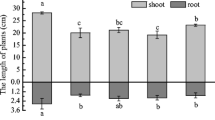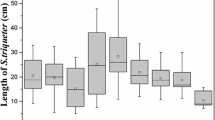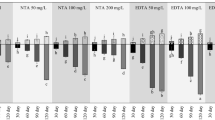Abstract
Remediation of heavy metal and polycyclic aromatic hydrocarbon (PAH)–co-contaminated soils has drawn much more attention; phytoremediation is an often-used technique. Sudan grass (Sorghum sudanense (Piper) Stapf.) with developed root system and strong PAHs and heavy metal tolerance is a potential choice for phytoremediation. In this study, the application of tea saponin (TS) (1 g kg−1 soil) and nitrilotriacetic acid (NTA) (1 g kg−1 soil) was to improve the removal efficiency of Ni and pyrene. TS and NTA had no obvious effects on the growth and soluble proteins of Sudan grass. Ni concentration in root was higher than that in the shoot. The addition of TS and NTA increased the Ni concentration in the root by 25.98% in Ni-contaminated treatment. Pyrene was mainly accumulated in the shoot of Sudan grass. Pyrene concentration in shoot increased by 20.14% with TS-NTA in pyrene-contaminated treatment and increased by 31.97% in Ni-contaminated treatment. TS and NTA had significantly improved dissolved organic matter and soil microbial activity. Microbial activity increased by 16.75%, 18.07%, and 23.364% in pyrene-contaminated, Ni-contaminated, and pyrene and Ni–co-contaminated treatment, respectively. This study showed that phytoremediation of pyrene and Ni–co-contaminated soil by Sudan grass could be enhanced by the application of TS-NTA and the interaction between pyrene and Ni impacted the accumulation of Ni and pyrene in Sudan grass.






Similar content being viewed by others
References
Anyasi RO, Atagana HI, Sutherland R (2019) Identification and characterization of PAH-degrading endophytes isolated from plants growing around a sludge dam. Int J Phytoremediat 21:672–682
Bauddh K, Singh RP (2015) Effects of organic and inorganic amendments on bio-accumulation and partitioning of Cd in Brassica juncea and Ricinus communis. Ecol Eng 74:93–100
Bradford MM (1976) A rapid and sensitive method for the quantitation of microgram quantities of protein utilizing the principle of protein-dye binding. Anal Biochem 72:248–254
Cay S (2016) Enhancement of cadmium uptake by Amaranthus caudatus, an ornamental plant, using tea saponin. Environ Monit Assess 188:320
Chen X, Liu XY, Zhang XY, Cao LY, Hu XX (2017) Phytoremediation effect of Scirpus triqueter noculated plant-growth-promoting bacteria (PGPB) on different fractions of pyrene and Ni in co-contaminated soils. J Hazard Mater 325:319–326
Cheng M, Zeng GM, Huang DL, Yang CP, Lai C, Zhang C, Liu Y (2018) Tween 80 surfactant-enhanced bioremediation: toward a solution to the soil contamination by hydrophobic organic compounds. Crit Rev Biotechnol 38:17–30
Dai YY, Liu R, Zhou YM, Li N, Hou LQ, Ma Q, Gao B (2020) Fire Phoenix facilitates phytoremediation of PAH-Cd co-contaminated soil through promotion of beneficial rhizosphere bacterial communities. Environ Int 136:105421
Fashola MO, Ngole-Jeme VM, Babalola OO (2016) Heavy metal pollution from gold mines: environmental effects and bacterial strategies for resistance. Int J Environ Res Pub Health 13:20
Fei L, Xu PX, Dong Q, Mo Q, Wang ZL (2018) Young leaf protection from cadmium accumulation and regulation of nitrilotriacetic acid in tall fescue (Festuca arundinacea) and Kentucky bluegrass (Poa pratensis). Chemosphere 212:124–132
Huang XC, Tang KL, Xu XP, Cai CT (2017) Interaction of Fe-Mn plaque and Arthrobacter echigonensis MN1405 and uptake and translocation of Cd by Phytolacca acinosa Roxb. Chemosphere 174:585–592
Huang HM, Zhao YL, Xu ZG, Zhang W, Jiang KK (2019) Physiological responses of Broussonetia papyrifera to manganese stress, a candidate plant for phytoremediation. Ecotox Environ Safe 181:18–25
Kang FX, Chen DS, Gao YZ, Zhang Y (2010) Distribution of polycyclic aromatic hydrocarbons in subcellular root tissues of ryegrass (Lolium multiflorum Lam.). BMC Plant Biol 10:7
Kibblewhite MG (2018) Contamination of agricultural soil by urban and peri-urban highways: an overlooked priority? Environ Pollut 242:1331–1336
Li NY, Guo B, Li H, Fu QL, Feng RW, Ding YZ (2016) Effects of double harvesting on heavy metal uptake by six forage species and the potential for phytoextraction in field. Pedosphere 26:717–724
Liang XJ, Guo CL, Liao CJ, Liu SS, Wick LY, Peng D, Yi XY, Lu GN, Yin H, Lin Z, Dang Z (2017) Drivers and applications of integrated clean-up technologies for surfactant-enhanced remediation of environments contaminated with polycyclic aromatic hydrocarbons (PAHs). Environ Pollut 225:129–140
Liao CJ, Liang XJN, Lu G, Thai T, Xu WD, Dang Z (2015) Effect of surfactant amendment to PAHs-contaminated soil for phytoremediation by maize (Zea mays L). Ecotox Environ Safe 112:1–6
Lin YL, Zhang Y, Zhang FQ, Li R, Hu Y, Yu H, Tuyiringire D, Wang L (2019) Effects of bok choy on the dissipation of dibutyl phthalate (DBP) in mollisol and its possible mechanisms of biochemistry and microorganisms. Ecotox Environ Safe 181:284–291
Liu XY, Cao LY, Wang Q, Zhang XY, Hu XX (2017) Effect of tea saponin on phytoremediation of Cd and pyrene in contaminated soils by Lolium multiflorum. Environ Sci Pollut Res 24:18946–18952
Liu XY, Cao LY, Zhang XY, Chen J, Huo ZH, Mao Y (2018) Influence of alkyl polyglucoside, citric acid, and nitrilotriacetic acid on phytoremediation in pyrene-Pb co-contaminated soils. Int J Phytoremediat 20:1055–1061
Liu XY, Mao Y, Zhang XY, Gu PX, Niu YH, Chen XL (2019) Effects of PASP/NTA and TS on the phytoremediation of pyrene-nickel contaminated soil by Bidens pilosa L. Chemosphere 237:124502
Lopez-Gonzalez JA, Lopez MJ, Vargas-Garcia MC, Suarez-Estrella F, Jurado M, Moreno J (2013) Tracking organic matter and microbiota dynamics during the stages of lignocellulosic waste composting. Bioresour Technol 146:574–584
Lu HN, Wang W, Li F, Zhu LZ (2019) Mixed-surfactant-enhanced phytoremediation of PAHs in soil: bioavailability of PAHs and responses of microbial community structure. Sci Total Environ 653:658–666
Maity JP, Huang YM, Hsu CM, Wu CI, Chen CC, Li CY, Jean JS, Chang YF, Chen CY (2013) Removal of Cu, Pb and Zn by foam fractionation and a soil washing process from contaminated industrial soils using soapberry-derived saponin: a comparative effectiveness assessment. Chemosphere 92:1286–1293
Maliszewska-Kordybach B, Smreczak B (2003) Habitat function of agricultural soils as affected by heavy metals and polycyclic aromatic hydrocarbons contamination. Environ Int 28:719–728
Nie J, Liu YG, Zeng GM, Zheng BH, Tan XF, Liu H, Xie JL, Gan C, Liu W (2016) Cadmium accumulation and tolerance of Macleaya cordata: a newly potential plant for sustainable phytoremediation in Cd-contaminated soil. Environ Sci Pollut Res 23:10189–10199
Pan G, Liu WS, Zhang HP, Liu P (2018) Morphophysiological responses and tolerance mechanisms of Xanthium strumarium to manganese stress. Ecotox Environ Safe 165:654–661
Perez RM, Cabrera G, Gomez JM, Abalos A, Cantero D (2010) Combined strategy for the precipitation of heavy metals and biodegradation of petroleum in industrial wastewaters. J Hazard Mater 182:896–902
Pilipovic A, Zalesny RS, Roncevic S, Nikolic N, Orlovic S, Beljin J, Katanic M (2019) Growth, physiology, and phytoextraction potential of poplar and willow established in soils amended with heavy-metal contaminated, dredged river sediments. J Environ Manag 239:352–365
Sarma H, Sonowal S, Prasad MNV (2019) Plant-microbiome assisted and biochar-amended remediation of heavy metals and polyaromatic compounds - a microcosmic study. Ecotox Environ Safe 176:288–299
Shim J, Babu AG, Velmurugan P, Shea PJ, Oh BT (2014) Pseudomonas fluorescens JH 70-4 promotes Pb stabilization and early seedling growth of Sudan grass in contaminated mining site soil. Environ Technol 35:2589–2596
Sivaram AK, Logeshwaran P, Lockington R, Naidu R, Megharaj M (2018a) Impact of plant photosystems in the remediation of benzo a pyrene and pyrene spiked soils. Chemosphere 193:625–634
Sivaram AK, Logeshwaran P, Subashchandrabose SR, Lockington R, Naidu R, Megharaj M (2018b) Comparison of plants with C3 and C4 carbon fixation pathways for remediation of polycyclic aromatic hydrocarbon contaminated soils. Sci Rep 8:2100
Sun TR, Cang L, Wang QY, Zhou DM, Cheng JM, Xu H (2010) Roles of abiotic losses, microbes, plant roots, and root exudates on phytoremediation of PAHs in a barren soil. J Hazard Mater 176:919–925
Sun MM, Ye M, Shen FY, Xu JJ, Ye CL, Yu L, Hu F, Li HX, Jiang X, Kengara FO (2016) Function of nitrate ion and tea saponin application rates in anerobic PAH dissipation in paddy soil. Clean-Soil Air Water 44:667–676
Tauqeer HM, Mahmoodur R, Hussain S, Abbas F, Iqbal M (2019) The potential of an energy crop “Conocarpus erectus” for lead phytoextraction and phytostabilization of chromium, nickel, and cadmium: an excellent option for the management of multi-metal contaminated soils. Ecotox Environ Safe 173:273–284
Wang SX, Zhang L, Jiang ML, Wang J, Xia FZ, Shi L, Xia Y, Chen C, Shen ZG, Chen YH (2020) Cyclic and safety utilisation of Cu polluted biogas residue in saline-alkali soil. Sci Total Environ 704:135410
Wei R, Ni JZ, Li XY, Chen WF, Yang YS (2017) Dissipation and phytoremediation of polycyclic aromatic hydrocarbons in freshly spiked and long-term field-contaminated soils. Environ Sci Pollut Res 24:7994–8003
Wiszniewska A, Muszynska E, Hanus-Fajerska E, Dziurka K, Dziurka M (2018) Evaluation of the protective role of exogenous growth regulators against Ni toxicity in woody shrub Daphne jasminea. Planta 248:1365–1381
Xu YF, Dai SX, Meng K, Wang YT, Ren WJ, Zhao L, Christie P, Teng Y (2018) Occurrence and risk assessment of potentially toxic elements and typical organic pollutants in contaminated rural soils. Sci Total Environ 630:618–629
Xu ZK, Shao TY, Lv ZX, Yue Y, Liu AH, Long XH, Zhou ZS, Gao XM, Rengel Z (2020) The mechanisms of improving coastal saline soils by planting rice. Sci Total Environ 703:135529
Yan L, Li CL, Zhang JJ, Moodley O, Liu SR, Lan C, Gao Q, Zhang WJ (2017) Enhanced phytoextraction of lead from artificially contaminated soil by Mirabilis jalapa with chelating agents. Bull Environ Contam Toxicol 99:208–212
Yu XL, He Y (2018) Tea saponins: effective natural surfactants beneficial for soil remediation, from preparation to application. RSC Adv 8:24312–24321
Yu FM, Li Y, Li FR, Li CM, Liu KH (2019) The effects of EDTA on plant growth and manganese (Mn) accumulation in Polygonum pubescens Blume cultured in unexplored soil, mining soil and tailing soil from the Pingle Mn mine, China. Ecotox Environ Safe 173:235–242
Yu HY, Zhan J, Zhang QP, Huang HG, Zhang XZ, Wang YD, Li TX (2020) NTA-enhanced Pb remediation efficiency by the phytostabilizer Athyrium wardii (Hook.) and associated Pb leaching risk. Chemosphere 246:125815–125815
Zhang XY, Chen J, Liu XY, Gao MJ, Chen XP, Huang C (2019) Nickel uptake and distribution in Agropyron cristatum L. in the presence of pyrene. Ecotox Environ Safe 174:370–376
Funding
This work was supported by the project of the National Key Research and Development Program of China (No. 2018YFC1800600), the National Natural Science Foundation of China (Nos. 21677093, 21806100), and the Natural Science Foundation of Shanghai (No.18ZR1414100).
Author information
Authors and Affiliations
Corresponding author
Additional information
Responsible Editor: Elena Maestri
Publisher’s note
Springer Nature remains neutral with regard to jurisdictional claims in published maps and institutional affiliations.
Rights and permissions
About this article
Cite this article
Liu, X., Shen, S., Zhang, X. et al. Effect of enhancers on the phytoremediation of soils polluted by pyrene and Ni using Sudan grass (Sorghum sudanense (Piper) Stapf.). Environ Sci Pollut Res 27, 41639–41646 (2020). https://doi.org/10.1007/s11356-020-09934-3
Received:
Accepted:
Published:
Issue Date:
DOI: https://doi.org/10.1007/s11356-020-09934-3




